UPDATE as of 11/25/2009: Appeals Court Rules in favor of Bruce Ratner
 Download this full post in print-friendly PDF
Download this full post in print-friendly PDF
A Quick Tour of the Atlantic Yards Project
Once United, Now Divided
Do Scare Tactics Play a Role?
The Tables Are Turned
Let’s Examine the Evidence
Commentary
References, Records, Legal Docs
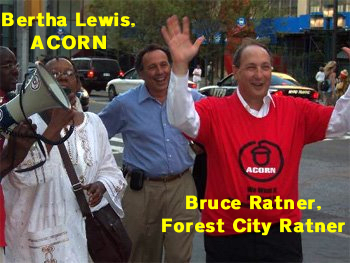 Amidst the coverage of ACORN for allegations of voter registration fraud, the Rathke embezzlement scandal, the ACORN-8 civil lawsuit and Justice Department complaint, controversy over Project Vote and alleged misuse of the Obama donors list, and most recently ACORN’s role in the upcoming Census in 2010, there lies a lesser told tale of controversy, conflict and allegation. Correction: it’s a feverishly told tale, at least in New York, but one largely ignored, perhaps because the very checks and balances that are supposed to be in place to expose allegations of impropriety apparently fall by the wayside when the media itself becomes part of the story (allegedly…).
Amidst the coverage of ACORN for allegations of voter registration fraud, the Rathke embezzlement scandal, the ACORN-8 civil lawsuit and Justice Department complaint, controversy over Project Vote and alleged misuse of the Obama donors list, and most recently ACORN’s role in the upcoming Census in 2010, there lies a lesser told tale of controversy, conflict and allegation. Correction: it’s a feverishly told tale, at least in New York, but one largely ignored, perhaps because the very checks and balances that are supposed to be in place to expose allegations of impropriety apparently fall by the wayside when the media itself becomes part of the story (allegedly…).
This is a long, complex story that has many twists and turns, and many angles (angles that, quite frankly, I’d consider more important than the one I’m going to cover here). This is a compartmentalized version of a broader story, and will focus primarily on its relevance to ACORN.
On December 10, 2003, one of the most ambitious real estate development projects in the history of Brooklyn was announced, a project that would later unfold into layers of conflict and speculated corruption, and be considered by many to be “the most controversial project ever in New York.”
The Atlantic Yards project, an endeavor of high-profile real estate developer Bruce Ratner and his Forest City Ratner companies, is a 22-acre mixed-use commercial and residential development project that cuts through the neighborhoods of Prospect Heights and Park Slope in Brooklyn, NY.
A Quick Tour of the Atlantic Yards Project
The project’s footprint is massive in nature, especially given the size and makeup of the area in which it will be located, which covers an area of a few

Click to enlarge
blocks. To be built above the Vanderbilt Rail Yards and pervading the residential blocks of Pacific and Dean Streets where they intersect with Flatbush and Vanderbilt Avenues, 17 buildings, some as high as 600 feet, will consume the neighborhood. Atlantic Yards will consist of:
- Barclay’s Center, an 850,000 square foot sports and entertainment arena to house the Brooklyn Nets and other performance venues
- 336,000 square feet of office space
- a 180-room boutique hotel
- 247,000 square feet of ground-floor retail space for local businesses
- more than 6,400 units of residential condominiums, 50% of which will be designated as affordable housing pursuant a Community Benefits Agreement that was negotiated between Ratner and ACORN et al
While some of the area slated for development consists of unused rail yards and some abandoned historic buildings, such as the Ward Bread Bakery building and the Long Island Railroad Stables building, a portion of the area also consists of private residences, many of them historic brownstones and low-rise buildings that have been renovated or restored by their owners over the years to turn the area into a thriving, diversified community. Many have longed for the rail yards to be developed, including residents; however, they’ve long expected any development would remain in keeping with the general feel of the community.
The tricky thing here is that the development site straddles an area that intersects between a lower-income neighborhood that is made up of predominantly minority residents, and a moderate income neighborhood that is predominantly white (some younger, more recent transplants, some from generations of Italian, Jewish, and German immigrants). Over the years, as transplants have settled in the Prospect Heights neighborhood and begun renovating and restoring many of the brownstone and low-rise properties and opening up small businesses, residents of the adjacent neighborhood of Park Slope have complained that the gentrification of Prospect Heights has increased both the median income and the housing prices for the area, making housing less affordable to the lower income residents of Park Slope and other nearby communities. Further, those concerned about accessible housing for low-income residents have feared the situation would worsen as a result of the Atlantic Yards project, given the addition of so much luxury housing and commercial development to the area. Minority community organizations had speculated that thousands of minority and immigrant populations will be displaced.
Once United, Now Divided
Sufficed to say, the Atlantic Yards project has been met with opposition from many groups since its announcement, each of them making some of the following arguments.
- Residents will suffer the obvious impact to their own homes – their surroundings will be overwhelmed by enormous towers and huge increases in traffic, people, noise and pollution; many will even lose their homes altogether to demolition. Those who do remain are concerned about having open public spaces and open streets ideal for proper community building.
- Local businesses (and residents) want to preserve small, local retail and fear the new retail space will far exceed their level of affordability and will cater instead to corporate and chain businesses.
- Environmentalists want the plan to reuse some existing buildings and work them into the overall aesthetic of the existing neighborhood; they also want the design substantially reduced to better manage gridlock and pollution, as well as make use of sustainability models.
- Historic Preservation groups want to keep the existing brownstones in tact, and want to preserve the historic buildings in the area and the nature of the surrounding architecture and landscape.
- Transportation agencies are concerned about the lack of planning to divert congestion, and manage parking issues and mass transit inefficiencies.
- Community Advocates insist that the project will cause the neighborhood to undergo an accelerated gentrification process and make the area unaffordable to the average Brooklyn resident.
- The public in general, at least those familiar with the area, have opposed the lack of public input in planning and decision making, which has largely been made behind closed doors and without any non-partisan entity to represent the interests of the public.
As opposition groups formed, controversy began to grow over the media coverage of the Atlantic Yards project. As a joint partner of Forest City Ratner, there had already been rampant criticism of the New York Times in 2001 for its business relationship with Forest City Ratner and their use of eminent domain to build the new New York Times headquarters building in Times Square, which opened in 2007. Charges of impropriety and conflict of interest eventually ran through various city agencies, the Empire State Development Corporation, Forest City Ratner as well as the New York Times itself, given that all had a vested interest in good media coverage and quelling opposition. An obvious concern therefore with the Atlantic Yards project, both of Brooklyn residents and other media outlets, was whether the New York Times, once considered to be *the* authoritative source of area coverage, could possibly report objectively this time around. With the media desperately needed to serve its role as one of the necessary checks and balances in this case, residents especially became skeptical and eventually fearful of the Times coverage. They recognized early on that building and maintaining support for the Atlantic Yards project would be key for Ratner and for the New York Times. And, here we were, just off the heels of the New York Times-Ratner Times Square building project, repeating the same scenario again.
As controversy grew, the nature of the New York Times’ coverage – or lack thereof – was frequently called to task. Any coverage that the paper did provide on the Atlantic Yards project was viewed as overwhelmingly supportive, and often seemed even to lean toward supporters of the project. Local papers in the heart of those communities, such as The Brooklyn Paper, covered the story with a view from the inside, often times exposing woeful inadequacies of the Times coverage. The IFC Media Project, even featured a segment alleging that one of that paper’s reporters, Deborah Kolben, was even fired by her prior employer, The Daily News, at the request of Bruce Ratner himself, apparently because Ratner found her coverage to be less than complimentary.
There were additional reports that the New York Times was not presenting a balanced view of the story; some even suggested that the publication was working with Ratner to purposely pit the communities against each other, making race and socio-economic status the characteristics that determined the project’s supporters versus the opposers. When affordable housing was added to the project’s plans through the efforts of ACORN, the gamefield shifted – opposers were portrayed as “greedy white people” who didn’t care about the housing and jobs that the project would bring to the community, a mantra echoed from all the way up to Mayor Bloomberg, Governors Spitzer and Paterson, Chuck Schumer, and the rest of the state’s Congressional representatives.
In addition, there were claims that the Times coverage was notably absent about several key issues that included allegations against ACORN and BUILD, groups that participated in the controversial Community Benefits Agreement, which includes stipulations that are questionable to say the least (more on that later). What had started out as a willing effort amongst the affected communities to work together to present an alternative proposal that would preserve the personality and diversity of their communities, while protecting existing homes, and creating new affordable housing and jobs, had evidently been manipulated into a race war and a class war of sorts.
Do Scare Tactics Play a Role?
In retrospect, one of the earliest opposers of Bruce Ratner was actually Bertha Lewis, of the Association of Community Organizers for Reform Now (ACORN). Years earlier, when Forest City Ratner had opened its Atlantic Center in Brooklyn, only blocks from the current Atlantic Yards project, Lewis staunchly opposed Ratner by organizing picketers, even storming his office. She demanded that the businesses located in the retail space of Ratner’s building pay their workers better wages, a fight she eventually won. And as new development has progressed in Brooklyn neighborhoods over the years, Lewis and ACORN have consistently muscled the developers into meeting ACORN’s demands for affordable housing and other benefits for their communities, seemingly as payback for the developers’ driving up the median income and housing prices. And as a close working partner of unions such as SEIU, IBEW and AFL-CIO, ACORN frequently guns for all new development projects to create union jobs during construction and to maintain union workers once the projects are completed. They are known for using signature tactics against even the most reasonable of opposition, tactics that focus on manufacturing racial and socio-economic undertones when none initially exist; sometimes a few unknowingly take the bait and fall prey to the trap, more frequently, the aggression that accompanies their rhetoric simply intimidates the others into abandoning their cause altogether.

ACORN's stance before receiving Ratner cash
And, as the Atlantic Yards project progressed, this was precisely the case again with ACORN. When local residents living in the homes that are in the direct path of Atlantic Yards demolition banded together to create groups like “Develop Don’t Destroy Brooklyn” to try and oppose the massive development project and avoid an eminent domain land grab case, Bertha Lewis was initially helpful, according to reports, offering advice on how to “gum them up”, referring to slowing down the project by way of obstructing the process. Initally, ACORN opposed the Atlantic Yards project. However, as talks between ACORN and Ratner occurred in parallel, behind closed doors, it apparently did not take long for ACORN to seemingly change their tune and to start attacking opposers with divisive, confrontational rhetoric.
“It is because of race and class that whenever you have a small group of white liberals running and screaming about something, people think it’s important. They don’t have to worry about affordable housing. They don’t give a damn about people of color. All they care about is preserving their little Prospect Heights community,” Bertha Lewis said in statements to The Brooklyn Daily Eagle, 06/09/05
Despite the fact that the members of “Develop Don’t Destroy Brooklyn” (DDDB) were supportive of developing the community, simply on a much more understated scale, and that they fully embraced the notion of creating jobs and ensuring that designated affordable housing would be available to low and moderate income families, ACORN continued to drive a wedge between themselves and any opposers.
The Tables Are Turned
As weeks and months passed, the confrontations and the rhetoric seemed to keep heating up. More and more groups like ACORN and BUILD began to band together in fierce support for Ratner and the Atlantic Yards project. Meanwhile members of opposition groups like DDDB grew increasingly uncomfortable, and speculated that Ratner and other supporters, including some media, were intentionally creating a racially charged situation in order to intimidate project opponents into defeat. Words got really ugly on both sides, but even a prominent city council member (and former Black Panther) who was in favor of moving the project to his own district admittedly noted that there was manipulation going on and people abusing and hiding behind “the race card” in order to advance their own selfish agenda for their organization rather than work as a group of communities together.
By about May of 2005, when a Memorandum of Understanding was drawn and signed between Bruce Ratner and Bertha Lewis, the rhetoric between ACORN and DDDB and other Atlantic Yards opposition was reaching new heights. The entire focus of all development negotiations with any of the “public” groups had been quickly shifted to the benefits of affordable housing and “thousands of jobs” the project would bring to a community supposedly suffering economically. The project itself had grown significantly in scope and in budget. This was in stark contrast to what the residents of Prospect Heights and members of DDDB had been discussing with ACORN and other project advocates. To even the most unfamiliar outsider to the story, it seemed clear that public negotiations had been all but hijacked. With the focus of the Atlantic Yards project now placed squarely upon offering affordable housing, creating union jobs, paying a living wage to project workers and building tenant employees, and generating stimulus for a socio-economic depressed area and disadvantaged class of citizens, this changed the politics of the project from one of a private investor to one in which the state had a legal public interest in seeing completed. After hearing Bertha Lewis present her version of the plan and quoting some overly positive – and questionable – statistics, members of the other parties grew even more concerned and began challenging Lewis.
“In order to get the affordable housing, we’ve lost our sense of community and ability to have input into the public process,” said Candace Carponter, of DDDB at a joint panel discussion between the parties titled Affordable Housing and the Atlantic Yards Development. Carponter went on to explain that with the current plan as Lewis presented it, it would cost at least three times as much to build this as other organizations could do it, it would use eminent domain, and at least $1.5 to $2 billion to build the project. “This is a low-rise neighborhood.” Carponter said. “Most of the buildings are five or six stories. It’s Brownstone Brooklyn at its organic best.”
“The affordable housing, the promise of jobs are being used as a Trojan horse for a massive land grab,” Carponter continued. “It is not necessary to build an arena to build affordable housing.”
(Source: Atlantic Yards Report)
Throughout the discussion, the records indicate that words became quite heated, and there was a lot of back and forth challenging occurring between Bertha Lewis/ACORN and the other parties, who were supposed to be there to try and determine compromises and potential alternatives together. As more people challenged Lewis about the fact that she’d already independently signed a MOU with Ratner, which legally binds ACORN to publicly support the project, it became evident that the project would be moving forward, with its larger scale and revised focus firmly rooted without the rest of the public’s input.
One of the panelists, a non-partisan law professor, tried to bring the discussion back to the heart of the matter. “I’m going to put to one side the obvious questions that this raises, which is: ‘Why isn’t the government speaking for the community?’ What’s wrong with our processes?”
As members of DDDB responded with their concerns over the now evident issue of an abusive land-grab planned under the pretense of eminent domain, the discussion turned again to the ACORN agenda, as Bertha Lewis insisted that the real issue is “about black and brown people in Central Brooklyn.”

ACORN's stance today
Only one month later, the Community Benefits Agreement surfaced. This is a legally binding agreement between Ratner and several organizations, supposedly representing the interests of the public and making negotiated concessions amongst those parties.

Download the CBA
Those parties represented in the CBA?
- All Faith Council of Brooklyn
- ACORN
- Brooklyn United for Innovative Local Development (BUILD)
- Downtown Brooklyn Neighborhood Alliance (DBNA)
- Downtown Brooklyn Educational Consortium (DBEC)
- First Atlantic Terminal Housing Committee (FATHC)
- NY State Association of Minority Contractors (NYSAMC)
- Public Housing Communities (PHC)
You’ll notice that a key party is conspicuously missing from the CBA – DDDB, the very group from which many members actually live in homes that are in the direct path of the Atlantic Yards project. Several of the other parties listed in the CBA, most notably BUILD and ACORN, are alleged to have been recruited by the developer, given funds to operate in their designated roles for the AY project, and in some cases even given a salary by the developer (as is noted in the written contracts and agreements published by FCR). It would appear that there was hardly anything public about the input collected and the agreement drafted. Once the project turned into a “public housing, union jobs” project, it was turned into a land grab case under eminent domain, also making it eligible for state and federal funds.
While other community members tried to understand the latest turn of events and an apparent shutout from the public decision making process, some interesting documents turned up that brought some light to the issue, and helped solidify the beliefs of many that these were actually “paid supporters” against whom they were fighting.
Let’s Examine the Evidence
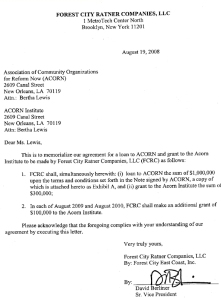
Click to enlarge
First was a document between Bruce Ratner’s Sr. Vice President, David Berliner, and Bertha Lewis/ACORN, signed on August 19, 2008. It is a written agreement for Forest City Ratner to provide a loan plus a grant to ACORN, totaling $1.5 Million.
So, the first question is:
What happened around August of 2008 that prompted the need for some cash for ACORN, that was negotiated so quietly? Other monetary negotiations for ACORN’s Atlantic Yards related activities were documented elsewhere, and made public. But not this. Why? I cannot answer that, so I’ll simply list some current events at that time – you can connect the dots:
- June 9, 2008: Strom’s NY Times story breaks, publicizing the Rathke $1 Million embezzlement scandal (which had been under wraps since it occurred in 2000). Further stories collaborated with Anita MonCrief follow from Strom. Until of course the stories get too close to ACORN and to the Ratner deal.
- August 2008: Marcel Reid, Karen Inman and the rest of the ACORN-8 (current and former ACORN members) file suit against ACORN to demand full financial disclosure
- August 22, 2008: “U.S. Sen. Barack Obama’s presidential campaign paid more than $800,000 to an offshoot of the liberal Association of Community Organizations for Reform Now for services the Democrat’s campaign says it mistakenly misrepresented in federal reports.”
Pittsburgh Tribune
- October 8, 2008: Miller and Grant vs. ACORN and Project Vote/Voting for America, Voter Registration Fraud lawsuit filed with Ohio Court of Common Pleas
Secondly, why did Bertha Lewis quietly negotiate her own Memo of Understanding with Ratner in such an underhanded manner? More importantly, why would Lewis commit herself to the strong language in the agreement, which states the following:

Download the full PDF
While the community groups that were supposed to be publicly negotiating together, in the interest of the neighborhood as a whole, were still conducting meetings and discussions, Bertha Lewis cuts a side deal with Bruce Ratner to ensure the ACORN housing proposal flies, no matter what the end solution is. She wants 50% of the residential units to be affordable housing. At a community planning meeting with the groups she’s supposed to be having open discussions with, she deflects challenges regarding this clause. Many residents speculate the agreement may be nothing more than a payoff.
Lewis ends the session, ““We don’t know what the state is going to allow Bruce Ratner to do,” she said. “Whatever the state allows him [Ratner] to do, the deal is 50/50…You guys are so fucking disrespectful. You would not ask Extell [an alternate proposal for consideration] this. Don’t talk to me, talk to the state.”
Lastly, there’s the publicly glorified “Community Benefits Agreement”, hailed as a great example of diplomacy and compromise in the community. Like the MOU that Bertha Lewis negotiated with Ratner on ACORN’s behalf, the CBA focused more on removing any obstacles to the AY project, by accommodating the specific needs of a select few organizations with an agenda. And it contained the same clause as noted above in the MOU – this time for all 8 of the participating organizations. If the allegations are true, that’s sure a lot of “rent-a-mob” employees.
 Download the Community Benefits Agreement
Download the Community Benefits Agreement
Probably most controversial throughout the later history of the project however, has been the use (or abuse) of eminent domain (and this is part of the bigger story I’d encourage readers to explore). In order to achieve the full scope of the project, Ratner and the city invoked the use of eminent domain to seize 68 privately held properties from residents wishing to remain in their homes. To many, this appeared to be a clear abuse of the law. After filing suit against Ratner, Mayor Bloomberg and Governor Pataki, residents and a local business owner alleged “the Project itself was conceived by Ratner, and is being driven by his needs, motives, and vision, not those of the public at large,” challenging the constitutional use of eminent domain in this case. Plaintiffs also claimed that Bloomberg and Pataki have backed the proposal and guarded it from review by community boards or the City Council, keeping the public from providing input or offering alternatives. At state senate hearings, the Ratner camp was spotted handing out hard hats, vests and whistles to “union members” who then marched outside and into the building in support of the project. It’s been a frequent sight, and one blogger called it “manufactured chaos”. Funny thing, it is such a well known tactic seen regularly at rallies where ACORN and SEIU are the hired rent-a-mobs.
As ACORN supported Democratic candidates in local, state and federal elected positions, both financially and by way of sheer people support at events, some under its ACORN name, some under the “Working Families Party” name (also see Lewis, Co-Chair), and others through any of the many ACORN affiliates (i.e. CCI), support from government officials for the Atlantic Yards project grew stronger and stronger.
Meanwhile, IRS filings for Ratner’s other big (hired) support group BUILD indicated that its entire $5 Million budget from 2005 and 2006 was solely funded by Ratner (see “IRS documents show BUILD relies on Ratner–but the Times ignores the Daily News’s scoop” under References below). When residents alerted the NY Times, once again, the paper simply made no mention of it.
And in the End…
Long story short, after back and forth lawsuits, the project may finally be moving ahead, sort of. A panel of four New York appellate judges ruled May 16th, 2009 that Forest City Ratner’s use of eminent domain to take private property to build a new home for the Nets does not violate the state Constitution.
Read a Daily News article on this decision
So, six years later, while once thriving businesses and family residences now lie in ruins, demolished in anticipation of the new development, the Atlantic Yards project is expected to resume once again, legal battles supposedly having been cleared away…for now. Meanwhile, ACORN has continued its undying, unconditional support of Bruce Ratner’s Atlantic Yards project even though there is barely any talk of affordable housing any more, let alone actual construction of any.
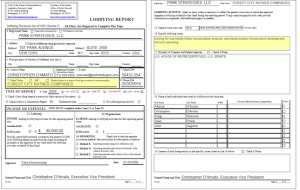
Download the full PDF
But that hasn’t stopped Ratner or ACORN from lobbying for federal stimulus funds to subsidize the Atlantic Yards monstrosity. And guess what? They’ve been getting them, at least by way of qualifying for breaks on bonds – and they’re still trying, with some help from folks like Chuck Schumer and Al D’Amato and his Park Strategies outfit.
And the New York Times? They remain conspicuously subdued – even absent – in their coverage, unless it’s positive news, of course. And forget any reporting on the ACORN front. As a joint partner with 48% shared ownership of several Forest City Ratner projects including their own building, they wouldn’t risk losing the largest supporter, most powerful muscle machine, most successful fundraiser and most influential federal-grant-funneling partner they’ve got in ACORN.
Commentary
I’ll conclude by offering my own commentary, and by posing a few questions for the reader to consider.
Let me preface this by stating that I fully support the principle of a non-profit organization that solicits funding for programs to aid disadvantaged citizens in any way, so long as it is private funding. My own upbringing was that of a disadvantaged citizen, the child of a single mother, living barely above the federal poverty level in a declining railroad community. But our founding fathers were very clear about their beliefs that private citizens and private businesses are the best resources to aid the general public, not the government. And I have found this to be true. The funds and resources allocated by the private sector for such purposes are far more efficiently managed, and the potential for corruption is significantly reduced, especially since the element of political campaign contributions and the exchanging of favors is removed. My community and empathetic citizens and private organizations aided me and my family far better than the government could.
Given this background, I fundamentally disagree with the approach that organizations like ACORN take in trying to better the lives of minorities and the disadvantaged. The model of government regulation and entitlement programs has long been proven to hold back such groups, and often contributes to the financial stagnation of impoverished neighborhoods and decay in job growth. If my tax-payer dollars are going to be allocated somewhere, I would prefer the money goes to reputable, private organizations with a proven model of success behind which I can proudly stand.
Secondly, the standard tactics consistently employed by ACORN specifically are something that I just find to be reprehensible. I would never support anyone or any organization that employs bullying, confrontational or intentionally divisive tactics to selfishly further its own causes. That is the ACORN that I’ve seen in action at events I’ve attended and communities in which I’ve lived. And since I would never financially support such behavior willingly, it infuriates me that I am forced to support this behavior unwillingly, as a tax-payer. What is most unfortunate is that this image is what discredits any of the good intentions that ACORN may have had, or the honorable activities they may have conducted at any time. And I know that there are still some good people in ACORN, and some good people who’d left, who somehow still believe the ACORN name can be repaired.
The reality is that this is an organization that has already admitted to embezzling $1 million, admitted to never having notified the authorities or their donors (a whistleblower had to do it for them), and has several current lawsuits against it (and despite their claims, the lawsuits do name ACORN, the group, as a defendant). Yet, this is an organization that receives millions of dollars in federal funding every year – money that comes from American taxpayers, many of whom I would venture to guess strongly and fundamentally disagree with their principles and their methods. This is an organization with the power to organize millions of union members to support any cause it desires, the power to influence the decisions of our nation’s lawmakers, the power to force private businesses to change their practices, even the power to force our nation onto government health care. This is an organization that has publicly denounced capitalism and free markets, the very principles upon which our nation and its Constitution are founded.
I vehemently disagree with every one of the principles by which this organization operates. And yet, my government forces me to compromise my own values and to subsidize the very behavior that I despise, with my hard-earned tax dollars. Still worse, I watch my tax dollars go right back into the pockets of the very politicians I just voted against. Donated to them by ACORN.
Have we no more honest lawmakers anymore that are strong enough to stand up to this? Where is our representation, where are our voices? At a time when Americans are struggling to hold onto every dollar they make, why are our tax dollars being permitted to go to politicians by way of ACORN? And with an admitted embezzlement and a variety of lawsuits and allegations against them, why do they qualify for any federal funding? They receive plenty of private funding from groups like the Tides Foundation
I end by posing a few rhetorical questions:
- If an organization receives tax-payer funding of any kind, should that organization be allowed to donate to political campaigns or political causes?
- Should a non-profit organization that receives federal funding be permitted to enter into a legally binding agreement that requires that organization to publicly support a project – a project that has significant political implications? Should they be permitted to accept any sort of funds (donation, loan, salary, etc.) from that business?
- The media has a duty to serve the public with honesty and integrity in their crucial role in a system of checks and balances that were established by our founding fathers to keep politics and power in check. Where is the line drawn for the media when it comes to its business investments, partnerships, and associations? Can the public trust that a news outlet will remain objective if it has a vested interest in other business matters?
References, Records, Legal Docs
Financial Records & Legal Docs:
References/Links:
- Atlantic Yards Report
Norman Oder’s blog. (THE source for all things AY, Ratner and ACORN). Journalist for more than 20 years–as a daily reporter, and later as a freelancer for publications from The American Lawyer to Columbia Journalism Review to the Village Voice. Also Master of Studies in Law from Yale on fellowship.
- In March, Congressman Bill Pascrell of NJ wrote a letter to Timothy Geithner, Ben Bernanke, and Rep. Barney Franks, requesting that the Treasury intervene in allowing Barclay’s to spend $400 Million on naming rights over the Atlantic Yards arena, citing Barclay’s receipt of federal bailout money. Read the Letter
- Develop Don’t Destroy Brooklyn
- ACORN
- Brooklyn United for Innovative Local Development (BUILD)
NOTE: Most of the content on this site has not been updated since 2004.
- Empire State Development Corporation
- Working Families Party
- Amicus Brief from BUILD
- Group Letter to the state assembly and senate asking for Forest City Ratner’s proposal to go through the City’s democratic development review process known as the Uniform Land Use Review Procedure (ULURP).
- The Complete Guide to ACORN Voter Fraud (Pajamas Media)
- Judicial Watch: ACORN/Census Bureau Documents
- Atlantic Yards website
- The Paper of Wreckage (Village Voice on the NY Times)
- Bailout! Feds save Ratner millions with new ruling
- The Brooklyn Paper: Ratner hosts rally to support…himself!
- Time to stop bullying at Atlantic Yards
- A local resident and photographer has created a collection of photos from the area, including before and after shots of buildings as they are demolished. It is an excellent view into what’s really going on for those who’ve lived in the community during all of this conflict.
- View a recreation of the story on video
Brooklyn at Eye Level, a Project of the Civilians. This renowned company develops original projects inspired from investigations into real life, using artistic and documentary methods. Excellent videos of their production put together the whole Atlantic Yards story, from the perspectives of different community leaders and residents.
ACORN makes much of its political donations through other 527s organizations, such as America Votes, in addition to joining forces with labor unions and other organizations that can make political donations under less restrictions than theirs (labor unions are supposed to be very rigid in campaign finance limitations; however, given the billions spent by unions annually in politics, it would appear that most have found ways to donate quite freely).
|
 Top 50 Federally Focused Organizations, 527s. Click to Enlarge. |
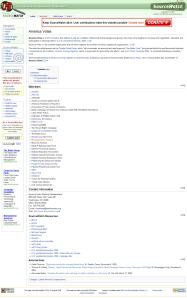 America Votes members, including ACORN & SEIU. Click to Enlarge. |
Legalish Disclaimer
With the exception of news or research content from third party sources, which is identified and specifically noted accordingly, the content on this blog is the opinion and original creation of the blogger, not intended to “malign any religion, ethnic group, club, organization, company, or individual,” or anyone or thing…in other words, I make every attempt to verify research and to be accurate and to give proper credit to sources; I also add opinion and commentary to such research, and I try to distinguish these as best I can to the reader. I always encourage readers to consult additional sources independently and not to rely solely upon any single source in forming their own opinions.


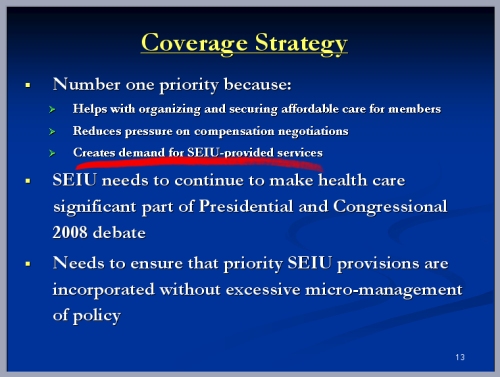

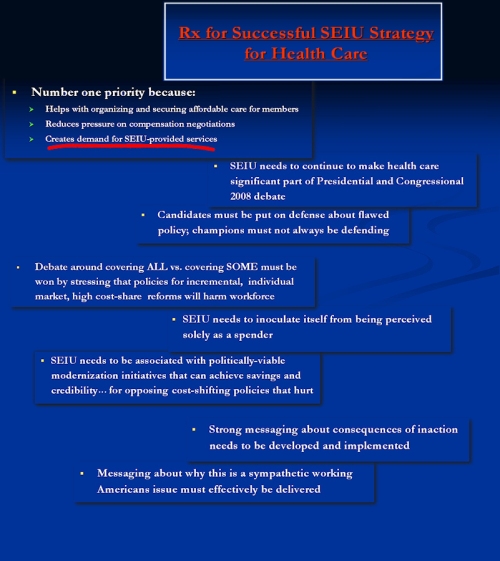
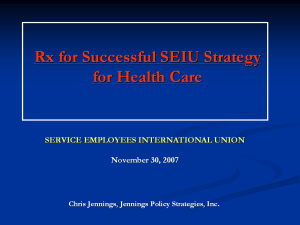


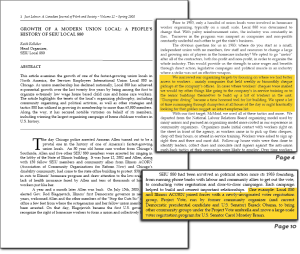
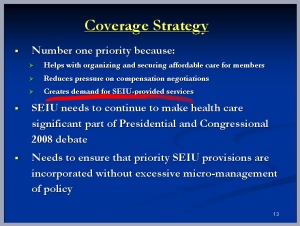
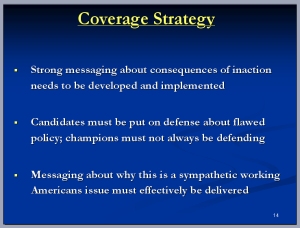
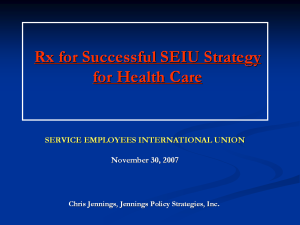


 Download this full post in
Download this full post in 















